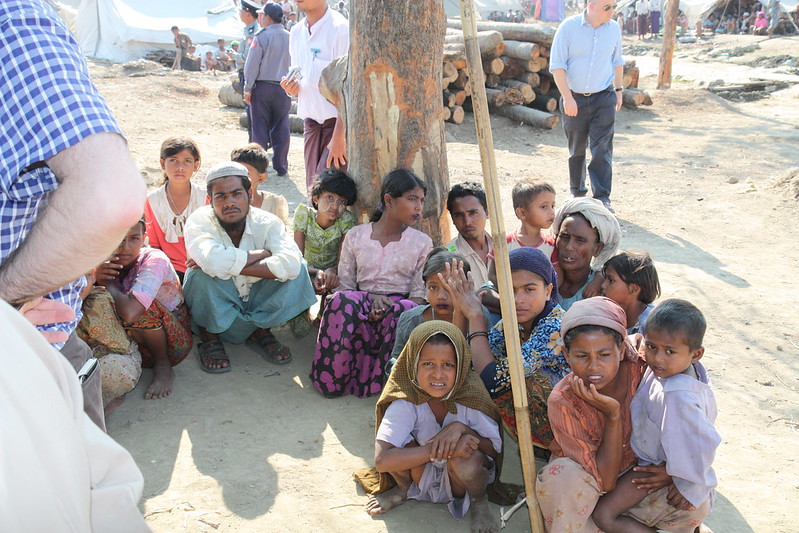The probe should determine how South Korea could let one of their ships become implicated in human rights offenses.
Myat Min Thu, formerly a Chief Petty Officer and mechanic in the Myanmar Navy, alerted South Korean authorities that the military had always intended to modify the UMS Mottama, originally requisitioned for humanitarian purposes in 2017, into an amphibious assault ship meant for direct action deployments.
Images of these plans, made public by the human rights group Justice For Myanmar (JFM), reveal five gun emplacements as part of the ship’s overall designs. The documents are dated sometime in 2018, after the export approval was granted for the ‘civilian vessel’.
His actions, Myat Min Thu said, came as a result of the 2021 military coup, which motivated him to defect and fight for his country on behalf of the people.
“He did not agree with the military coup that took place by the military junta,” his lawyer, Kinam Kim, told OCCRP. “He decided to leave the Navy so that he could join the civil revolutions movement.”
There are two sides, Myat Min Thu told OCCRP. One being “democracy, justice and equality,” which he called “the People’s Side,” while the other, he said, is the “Military Junta Dictator Side,” which he now fully opposes.
Due to safety concerns, he communicated with OCCRP from an undisclosed location via secure transmissions.
South Korea’s Defense Acquisition Program Administration in 2021 stated its intent to strengthen its export screening process and vowed to continue to monitor whether such vessels will be used “for purposes other than those for which they are permitted after export.”
In 2017, Daesun Shipbuilding & Engineering, a Korean company, requested permission to export a warship with amphibious assault and troop transport capabilities to Myanmar. The Ministry of Defense denied the request, citing stipulations under the Arms Trade Treaty.
Five months later, a follow-up request was made, this time by POSCO International, South Korea’s largest trading company, which called for a flagship vessel to be delivered for humanitarian and disaster response purposes, one that would be deployed exclusively to meet civilian needs.
Upon delivery in 2019, however, the Myanmar Navy proceeded to mount the guns onto the flagship, now designated the UMS Mottama. The electrical and communication system for the guns, however, were installed in South Korea, JFM said of the schematics leaked by Myat Min Thu.
In addition to its armaments, the ship also boasts several decks capable of housing landing crafts for hundreds of soldiers, multiple helipads, a hangar, and even a deck designated for storing tanks and armoured personnel carriers.
Boasting a deadly arsenal and a wide assortment of land warfare vehicles, the Mottama is designed to act as a force multiplier for any amphibious or marine engagement.
POSCO International told OCCRP that it was “not aware that the vessel would be diverted from its original usage” and that the ship was originally requisitioned through the proper legal channels.
The South Korean trading company further explained that, prior to greenlighting the project, a Myanmar Navy delegation “visited Korea to explain that the purpose of the vessel was for humanitarian assistance in response to increasing natural disasters in Myanmar,” and that the military attachés “submitted an official letter” from the Myanmar government expressing the same point.
POSCO International concluded by stating the organization that ultimately built the vessel, Dae Sun Shipbuilding, “is not a defense contractor company and is not authorized to construct warships or battleships that satisfy military specifications.”
This would mean that the Myanmar Navy acted of its own accord in modifying the Mottama from a humanitarian vessel into a military one.
The warship’s delivery to Myanmar came just after the military’s 2017 genocidal campaign against the Rohingya, an ethnic and religious Muslim minority, in which the Myanmar Navy took part. Hundreds of thousands of civilians have since fled the country for their lives, lest they face torture, rape, and the burning of their villages.
Reports have since surfaced that the navy has deployed the Mottama to quell dissent amongst the country’s own people.
“He [Myat Min Thu] believed that the military junta used that vessel to transfer military personnel and weapons to support the war against the other ethnic groups and other efforts confronting the junta,” Kinam Kim told OCCRP.
In June earlier this year, for instance, the Mottama was sighted in Myanmar’s Rakhine state, “to support a rapid buildup of ground forces” deployed against ethnic groups such as the Arakan Army, an open-source intelligence company reported.
Although a current ceasefire exists between the military and the Arakan Army, relations appear to be at a breaking point as the ethno-nationalist group continues to push for self-determination.
And in late May this year, the Mottama was spotted in the deep sea port of Kyaukphyu along the Rakhine coast, where it engaged in its first reported combat mission since its commission almost three years ago.
South Korea’s Defense Acquisition Program Administration in 2021 expressed “deep regret” over the export of the warship to Myanmar, which was utilized for military rather than humanitarian purposes, in direct violation of the original agreement.
South Korean authorities are also entertaining the idea to blacklist countries, or at least place restrictions on them, should they violate the expressed purposes for which they were originally granted the country’s military resources.
This story was updated with a comment from POSCO International

